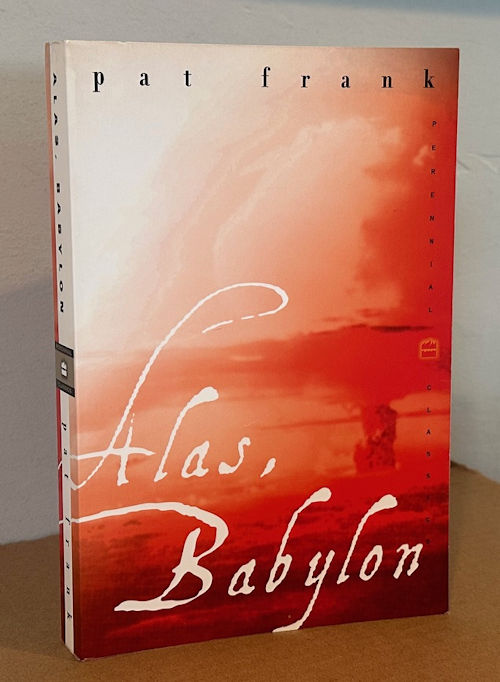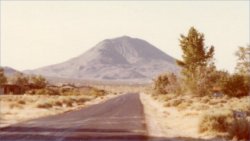(First published 1959. Edition here: HarperCollins/Perennial Classics, 1999, 323pp, including author biography and publication history by Hal Hager)
Next up in the group of apocalyptic novels I read in June, following Butler’s PARABLE OF THE SOWER, is this. It isn’t as famous as two other near-contemporaneous novels, ON THE BEACH from 1957 and FAIL-SAFE from 1962, since popular movies were made from both of them. (I think there was a TV version of this one.) The author was a journalist whose work took him into contact with military people who strategized various nuclear war scenarios. He was asked what would happen if nuclear war broke out. He said, “Oh, I think they’d kill fifty or sixty million Americans–but I think we’d win the war.” This was in the 1950s. Frank was similar to George R. Stewart, author of EARTH ABIDES (my review here), in that while both wrote other books and were moderately well-known in their day, they are remembered decades later only for one book each.
The previous time I read this it reminded me of a Stephen King novel.
It’s set in a small town, in this case in central Florida, and we’re introduced to a variety of characters, some ordinary and some eccentric, and come to understand the relationships between them. Then the big thing happens, and the characters react, and in some cases change how they behave toward others.
In this case the big thing that happens is the outbreak of nuclear war between the US and the Soviet Union, with both sides launching full attacks against hundreds of targets in the other, mostly cities and military bases. The town where this story happens, Fort Repose, is somewhere between Tampa and Orlando, and perhaps a little south, and so isn’t near any direct strike.
So the story is about the residents of this town and what happens as the infrastructure powered by those big cities goes out. With the big banks in the cities gone, local currency becomes worthless. After only a day or two, the power goes out, and “civilization in Fort Repose retreated a hundred years.” A barter economy quickly develops. No electricity means no running water; they resort to the river, or wells. People needing insulin die.
They hear snippets of news over the radio — the once Secretary of Health, Education, and Welfare is now president — but batteries run out. Months pass; gasoline runs out; they run out of salt. The major incident of the last part of the book is about how the town doctor is assaulted by highwaymen, and his bag stolen, and the de fact leader of the town sets out to find them, and kill them.
A full year later planes pass overhead and a military helicopter lands (rather as at the end of one of John Wyndham’s novels) to reassure the townspeople that there are other survivors out there, and American civilization will rebuild. Who won the war? the town asks; and the answer is: we did, not that it matters.
\
- This is an example of a cozy catastrophe, a story in which civilization is largely destroyed but the main characters of our story mostly survive and remain fairly well off. John Wyndham, again, wrote several such novels in the 1950s.
- Unlike many Hollywood movies and TV shows about such catastrophes, civilization does not devolve into savagery here. There are some villains — people who burn down a hotel, perhaps in search of supplies; and the highwaymen who rob passers-by — but the residents of the town remain civil. (A canonical example of how society supposedly becomes savage is that Twilight Zone episode called The Monsters are Due on Maple Street,from 1960, which I still see cited as an example of how the veneer of modern civilization is thin. But in the story, the residents of Maple Street were deliberately egged on by aliens, intent on taking over Earth once the human — the real monsters — killed themselves off.) There are a number of books that make the point that humans are generally cooperative, even in catastrophic situations. It’s just more dramatic to play up the chaos.
- Similarly to the situation of FAIL-SAFE, which I’ll to, the war in this book is started almost accidentally, and there are some dramatic scenes early in the book about a US pilot patrolling the Mediterranean is essentially tricked into firing a missile that hits a port city… and triggers retaliation.
- This book has a different take on the dangers of radiation than ON THE BEACH, another book I’ll get to. In this story, only direct contact with contaminated objects (from the cities) causes illness and death.
- Similarly to ON THE BEACH, on the other hand, is how residents of this town carry on with their daily lives — keeping the library open, say — even as the future is uncertain.
\
The prospect of nuclear war was heavy on the minds of people in the 1950s, with these and other books, like Walter M. Miller’s A CANTICLE FOR LEIBOWITZ (review here) being stand-out novels in the science fiction, or sf-adjacent, field. I was reminded by that Tom Nichols piece that I linked here 10 days ago, Damn You All to Hell!, subtitled “How Hollywood taught a generation to fear nuclear catastrophe”, which focuses and movies and TV shows, that such concerns didn’t die out in the 1960s. Rather, there was another round of movies, some on TV, like The Day After in 1983, which virtually everyone saw when it appeared, and others like Testament and Threads, which I didn’t. But lately modern takes or remakes have swapped out the nuclear theme for others, like biological warfare.
When I grew up in the 1960s the idea of a sudden alert was on everyone’s minds. Those were the days of “drop drills” in elementary school — a term apparently so antiquated, I can’t find a Wikipedia or Google page about it. As I recall, we would be instructed about what to do in the event an emergency, like a nuclear bomb going off nearby. Then at some point during the school day, through the semester, the teacher would abrupt announce “Drop!” And all us students would dive to the floor and huddle underneath our little desk-chairs, our hands over our heads, as if that would protect us from the power of a nuclear bomb. Well, it might protect us from frying shards of broken glass.






